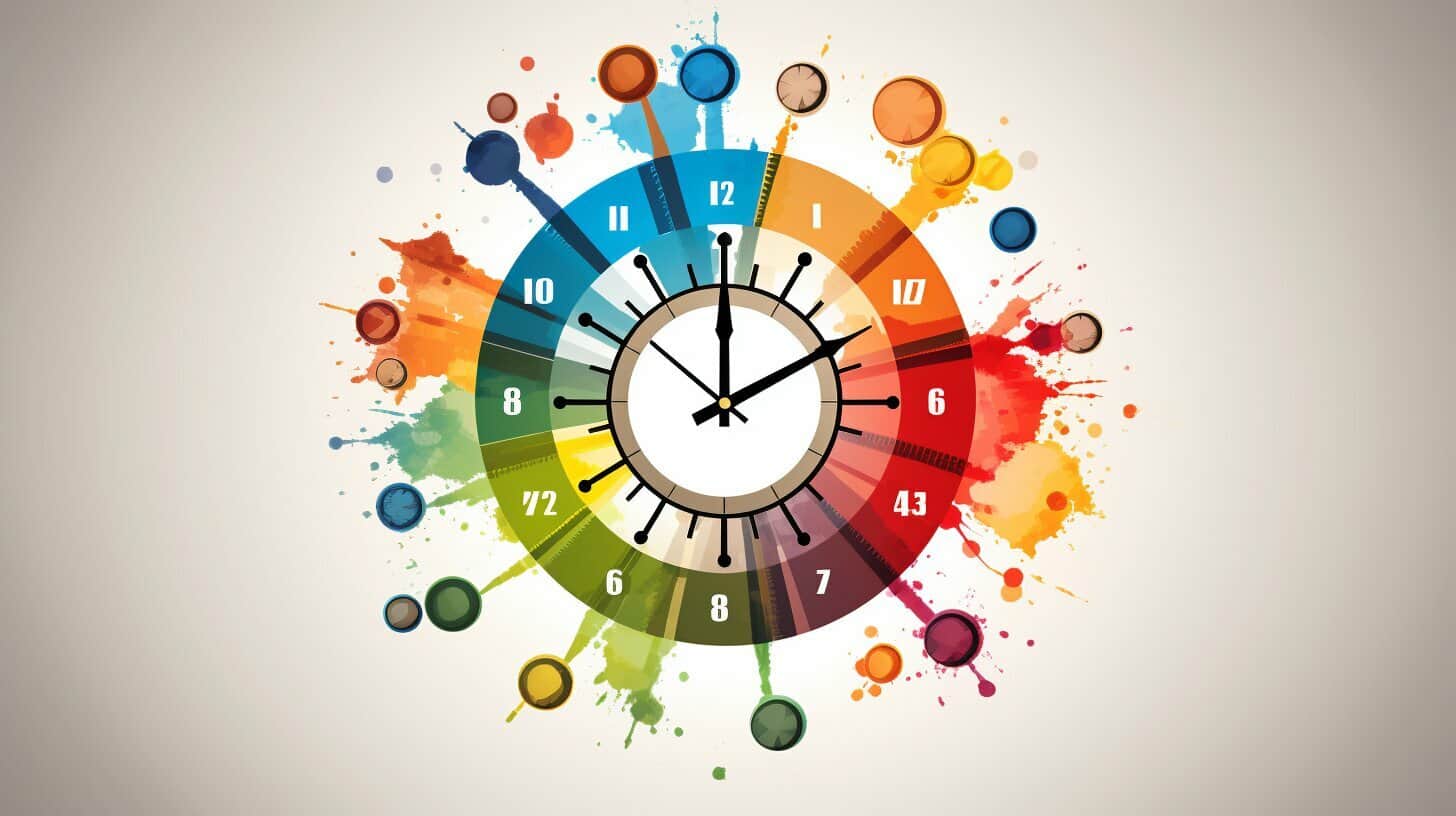As a professional, time is one of your most valuable resources. But in today’s fast-paced work environment, it’s easy to become overwhelmed and lose track of your priorities. That’s why it’s crucial to find ways to save time at work and maximize productivity.
In this article, I will share practical tips and strategies for saving time at work. By implementing these techniques, you can streamline your workflow, reduce stress, and achieve greater success in your professional life.
Key Takeaways:
- Efficiency is crucial in the workplace
- Assess your current time management strategies
- Prioritize your tasks using techniques like the Eisenhower Matrix and the ABC method
- Streamline your workspace by decluttering and organizing
- Minimize distractions to enhance productivity
- Delegate and outsource tasks when possible
- Utilize time-saving tools and technology
- Optimize your communication to save time
- Take regular breaks and practice self-care to maintain productivity
Assess Your Current Time Management Strategies
Before exploring effective time-saving strategies, it’s essential to assess your current workflow and identify areas for improvement. By evaluating your current time management strategies, you can identify time-wasting activities and take steps to optimize your workday.
Start by tracking your work activities for a few days to get a clear understanding of how you’re spending your time. Take note of how long you spend on each task and identify any patterns or activities that are consuming too much of your time.
Once you’ve identified your time-wasting activities, it’s time to prioritize your tasks. By setting clear priorities, you can focus on essential tasks and reduce the time spent on less important activities.
Assessing Your Workflow
To assess your workflow, start by answering the following questions:
| Questions to Consider | Notes |
|---|---|
| What are your top priorities? | Identify the most important tasks that require your attention. |
| What are your biggest time-wasters? | Identify activities that consume too much of your time or distract you from work. |
| What are your most productive times of day? | Identify the times of day when you’re most alert and focused. |
| What tools and resources do you need to work efficiently? | Identify the tools and resources that can help you work more efficiently. |
Identifying Time-Wasting Activities
To identify time-wasting activities, start by asking yourself:
- What tasks am I spending too much time on? – Identify tasks that take up more time than necessary or are not essential to your work.
- What distractions am I facing? – Take note of any distractions that are hindering your productivity, such as unnecessary meetings or constant interruptions.
- What activities do I enjoy but aren’t productive? – While breaks and leisure time are important, identify any activities that may be taking up too much of your time.
By answering these questions, you can gain a better understanding of your current workflow and identify areas for improvement. By assessing your workflow and identifying time-wasting activities, you can create a more efficient and productive work routine.

Prioritize Your Tasks
One of the best ways to save time at work is by prioritizing tasks. This means identifying which tasks are most important and urgent and tackling them first.
There are various techniques for setting priorities, such as the Eisenhower Matrix and the ABC method. The Eisenhower Matrix involves dividing tasks into four categories: important and urgent, important but not urgent, urgent but not important, and neither urgent nor important. The ABC method involves assigning priorities to tasks based on their level of importance.
To implement prioritization effectively, it’s important to set specific and achievable goals. Break down larger tasks into smaller, more manageable ones and assign deadlines to each task. This will help you stay focused and motivated throughout the workday.
The Eisenhower Matrix
| Important/Urgent | Important/Not Urgent |
|---|---|
| Do: Complete the task immediately | Decide: Plan a time to complete the task |
| Delegate: Assign the task to someone else | Delegate: Assign the task to someone else |
| Urgent/Not Important | Not Urgent/Not Important |
|---|---|
| Eliminate: Remove the task completely | Eliminate: Remove the task completely |
| Postpone: Schedule the task for later | Postpone: Schedule the task for later |
By prioritizing tasks, you can maximize your productivity and avoid wasting valuable time on low-priority activities. It’s important to continually evaluate your priorities and make adjustments as needed to stay on track and achieve your goals.
Streamline Your Workspace
Having an organized workspace can save you time and increase productivity. Cluttered surroundings can distract you and affect your ability to focus. Here are some tips for streamlining your workspace:
- Clear the clutter: Remove any unnecessary items from your workspace. Keep only the essentials within arm’s reach to avoid distractions.
- Organize digital files: Use folders and subfolders to organize your digital files. Create a system that works for you and stick to it.
- Create an efficient physical workspace: Arrange your desk to suit your work style. Keep frequently used items close by and less frequently used items further away. Consider investing in ergonomic furniture to avoid discomfort and reduce the risk of injury.
By streamlining your workspace, you can save time and increase your productivity, leading to a more efficient workday.

Minimize Distractions
Distractions are one of the biggest time-wasters at work. To stay focused and productive, I always make an effort to minimize distractions. Here are some strategies that have worked for me:
- Turn off notifications: I turn off all non-essential notifications on my computer and phone to avoid interrupting my work flow.
- Create a focused work environment: I try to find a quiet place to work where I won’t be distracted by others. If that’s not possible, I use noise-cancelling headphones to block out background noise.
- Implement time-blocking techniques: I set specific blocks of time for focused work and make sure I’m not interrupted during those periods. During breaks, I check emails and messages instead of constantly switching back and forth.
Minimizing distractions can be challenging, but it’s worth it for the productivity gains. By creating a focused work environment and utilizing time-blocking techniques, I’m able to stay on task and accomplish more in less time.
Delegate and Outsource Tasks
As much as we’d like to do everything ourselves, it’s simply not possible. Delegating and outsourcing specific tasks can help us save time and work more efficiently. Here are some tips for delegating and outsourcing effectively:
Identify the tasks to delegate
Identifying which tasks can be delegated can be a challenge. It’s important to take into account the skills and strengths of your team members and determine which tasks can be executed effectively by others. Typically, tasks that are repetitive, administrative, or require a lower level of expertise are good candidates for delegation.
Find reliable resources for outsourcing
If you’re outsourcing tasks outside of your team, it’s important to find reliable resources to ensure that the work is done correctly and efficiently. Freelance platforms such as Upwork and Fiverr are great resources for finding freelancers with specific skills. It’s important to take the time to vet potential candidates and read reviews from previous clients before hiring.
Communicate expectations clearly
Whether you’re delegating tasks within your team or outsourcing tasks, it’s important to communicate your expectations clearly and effectively. Clearly define the scope of the project, the timeline, and the desired outcome to ensure that everyone is on the same page. Provide regular feedback to ensure that the work is progressing as expected.
Delegating and outsourcing tasks can be a game-changer for time management and productivity. By identifying tasks to delegate, finding reliable resources for outsourcing, and communicating expectations clearly, we can save time and work more efficiently.

Utilize Time-Saving Tools and Technology
One of the best ways to save time at work is to utilize time-saving tools and technology. With advancements in technology, there are now numerous resources available that can help you streamline tasks and increase productivity. Here are some of my favorite time-saving tools and technologies:
| Productivity Apps | There are various productivity apps available that can help you manage your time efficiently. These apps can help you create to-do lists, set reminders, track your progress, and even block distracting websites. |
|---|---|
| Project Management Software | If you work with a team, project management software can be incredibly helpful. These programs allow you to delegate tasks, track progress, and communicate with team members all in one place. |
| Automation Tools | Automation tools can be a game-changer for repetitive tasks. With tools like IFTTT and Zapier, you can automate tasks like email sorting, social media posting, and even turning on your lights. |
By using these tools, you can save time and focus on the tasks that require your attention. However, it’s important to remember that technology is not a replacement for good time management habits. Use these tools in conjunction with other time-saving strategies to maximize their effectiveness.
Prioritize Your Communication
Effective communication is key to maximizing work time and maintaining productivity. By utilizing communication tools and techniques, you can streamline your communication process and avoid wasting time on unproductive conversations.
Email Management
Email can be a major source of distraction and time-wasting at work. To optimize your email communication, consider setting specific times during the day to check and respond to emails. You can also prioritize your inbox by using filters and labels to ensure you only see the most relevant messages. And, when drafting emails, aim to keep them succinct and to the point to avoid unnecessary back-and-forth.
Streamlined Meetings
In-person meetings can be a necessary part of communication, but they can also be a major time-sink. To optimize your meetings, set clear agendas and aim to keep discussions focused and on-topic. Consider limiting meeting times and avoiding scheduling meetings that could have been an email or discussion over a chat platform. You can also use technology, like video conferencing, to shorten travel time and increase flexibility for remote team members.
Communication Tools
There are a variety of communication tools available that can help you streamline your communication process. Consider using chat platforms, like Slack or Microsoft Teams, for quick conversations that don’t need an email or meeting. You can also use project management software, like Asana or Trello, to track task progress and communicate with team members. By utilizing these tools, you can keep your communication organized and optimized.

Prioritize Your Tasks
When it comes to optimizing your work time, prioritizing your tasks is one of the most important and effective techniques. By focusing on the most urgent and important tasks first, you can maximize your productivity and streamline your workflow.
One popular method for prioritizing tasks is the Eisenhower Matrix. It involves dividing your tasks into four categories: urgent and important, important but not urgent, urgent but not important, and neither urgent nor important. By assigning each task to a category, you can determine which tasks require immediate attention and which can be postponed or delegated.
Another useful method is the ABC method, where you label tasks as A, B, or C based on their priority. A tasks are the most important, B tasks are important but less urgent, and C tasks are least important. This method allows you to focus on the most crucial tasks while still making progress on lower-priority tasks.
Prioritize Your Tasks
Now that you have assessed your current time management strategies, it’s time to prioritize your tasks. By setting priorities, you can optimize your work time and achieve your goals more efficiently. There are several techniques you can use to set priorities, such as the Eisenhower Matrix and the ABC method.
The Eisenhower Matrix
The Eisenhower Matrix is a simple yet effective technique for prioritization. It involves dividing your tasks into four categories:
- Urgent and important tasks – these should be done first.
- Important but not urgent tasks – these should be scheduled for later.
- Urgent but not important tasks – these should be delegated or outsourced.
- Not urgent and not important tasks – these should be eliminated or minimized.
By using this method, you can focus on the tasks that require immediate attention and avoid wasting time on non-essential tasks.
The ABC Method
The ABC method involves labeling your tasks as A, B, or C based on their level of priority. A tasks are the most important, B tasks are moderately important, and C tasks are the least important. You can also assign each task a deadline to further prioritize them.
Once you have set your priorities, it’s important to follow through and complete your tasks accordingly. Make sure to tackle your A tasks first and avoid procrastination. By prioritizing your tasks, you can optimize your work time and achieve your goals more efficiently.
FAQ on Ways To Save Time At Work
Q: How can I save time at work?
A: There are several ways to save time at work. By assessing your current time management strategies, prioritizing your tasks, streamlining your workspace, minimizing distractions, delegating and outsourcing tasks, utilizing time-saving tools and technology, optimizing your communication, and taking regular breaks and practicing self-care, you can boost your efficiency and save valuable time.
Q: Why is efficiency important in the workplace?
A: Efficiency is important in the workplace because it allows you to accomplish more tasks in less time. By being efficient, you can increase productivity, meet deadlines, reduce stress, and improve the overall quality of your work.
Q: How can I assess my current time management strategies?
A: To assess your current time management strategies, you can evaluate your workflow, identify time-wasting activities, analyze your priorities, and track how you spend your time. This will help you identify areas for improvement and make necessary adjustments to optimize your time.
Q: What techniques can I use to prioritize my tasks?
A: There are various techniques you can use to prioritize your tasks. The Eisenhower Matrix and the ABC method are popular approaches. The Eisenhower Matrix helps you categorize tasks based on their urgency and importance, while the ABC method involves assigning priority levels to tasks. Experiment with different techniques and find the one that works best for you.
Q: How can I streamline my workspace?
A: To streamline your workspace, you can start by decluttering and organizing your physical and digital spaces. Keep only the essentials within reach and create a filing system for your digital files. Additionally, ensure that your workspace is free from distractions and optimized for your comfort and productivity.
Q: What can I do to minimize distractions at work?
A: Minimizing distractions at work involves turning off notifications on your devices, creating a focused work environment, implementing time-blocking techniques, and practicing self-discipline. By reducing interruptions, you can maintain your concentration and accomplish tasks more efficiently.
Q: How can delegating and outsourcing tasks save me time?
A: Delegating and outsourcing tasks can save you time by allowing you to focus on higher-priority and more specialized activities. By assigning tasks to others who are qualified and capable, you can free up your time and ensure that all necessary work is completed effectively.
Q: What time-saving tools and technology are available?
A: There are many time-saving tools and technologies available, such as productivity apps, project management software, automation tools, and communication platforms. These resources can streamline tasks, improve collaboration, and save you valuable time in your work.
Q: How can I optimize my communication to save time?
A: You can optimize your communication to save time by managing your emails effectively, streamlining meetings, utilizing communication tools efficiently, and practicing clear and concise communication. By improving the efficiency of your communication, you can minimize misunderstandings and wasted time.
Q: Why is taking regular breaks and practicing self-care important?
A: Taking regular breaks and practicing self-care is important for maintaining productivity and preventing burnout. By incorporating short breaks, physical activity, and mindfulness techniques into your workday, you can recharge your energy, improve focus, and enhance overall well-being.
Q: How can I apply the tips and techniques mentioned in this article?
A: To apply the tips and techniques mentioned in this article, start by identifying areas where you can make improvements. Then, gradually incorporate the strategies into your daily work routine. Experiment with different approaches and find what works best for you. Remember, consistency and practice are key to achieving greater efficiency and time savings.





Leave a Reply